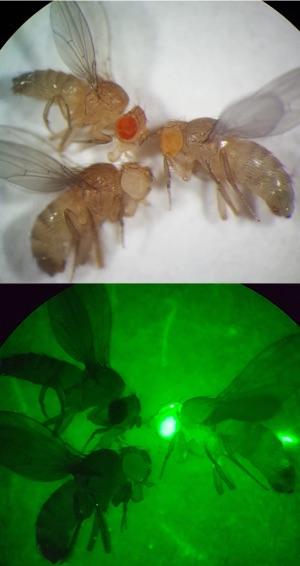The role of selfish genes in distinguishing a species

Credit: University of Nebraska photos / Rodolfo Villegas
Most evolutionary biologists distinguish one species from another based on reproductivity: members of different species either won’t or can’t mate with one another, or, if they do, the resulting offspring are often sterile, unviable, or suffer some other sort of reduced fitness.
For most of the 20th century, scientists believed that this reproductive incompatibility evolved gradually between species as a by-product of adapting to different ecological circumstances: if two species were geographically isolated, they would adapt differences based on their environment. New research conducted at the University of Rochester, in collaboration with the University of Nebraska, shows, however, that there are more factors at play–specifically the presence of selfish genes called meiotic drive elements, whose flow among species may dictate whether two species converge or diverge. In a new paper published in the journal eLife, the researchers show that sex chromosomes evolve to be genetically incompatible between species faster than the rest of the genetic chromosomes and reveal the factors at play in this incompatibility.
When two members of a species mate and exchange genetic material, this is known as gene flow. When two members of different species mate, however, gene flow is reduced. “Genes from one species simply can’t talk to genes from the other species,” says Daven Presgraves, a dean’s professor of biology at Rochester. Though the genes may work fine on their own genetic background, when they are moved into the genetic background of another species, they have negative effects. “All of the gene copies in you and me work in the human genome. But if we were to take a gene out of you and stick it in a macaw parrot, they haven’t seen this sequence before and it might not work together with the other genes. That would compromise some sort of function like fertility.”
This is what happened when Presgraves and members of his lab crossed two different species of fruit flies, one from Madagascar and the other from the island of Mauritius. When the two species were crossed, their female hybrid offspring were fertile, but the hybrid male offspring were completely sterile. “One of the steps on the way to complete reproductive isolation is that the XY sex becomes sterile first in that gradual build-up of incompatibility,” Presgraves says. In the case of fruit flies, as in human beings, the XY sex is male.
Chromosomes are divided into two types: allosomes, or sex chromosomes, and autosomes, or body chromosomes. Genetic traits linked to an organism’s sex are passed on through the sex chromosomes. The rest of the genetic hereditary information is passed on through the autosomes. When the researchers mapped the factors that cause hybrid males to become sterile, they found that there were many more incompatibility factors on the X allosome compared to the autosomes. This means that sex chromosomes become functionally different between species much faster than non-sex chromosomes, Presgraves says. “There’s a lot more exchange going on between the autosomes than on the X.”
But what is it that makes sex chromosomes accumulate genetic incompatibility faster than the rest of the genome?
The researchers found that a class of “selfish genes” called meiotic drive elements are responsible for making sex chromosomes genetically incompatible at a faster rate. In general, selfish genes are parasites of the genome–they propagate themselves at the expense of other genes. Meiotic drive elements in particular sabotage the rules of typical inheritance: in normal Mendelian inheritance, a gene is transmitted to half the offspring. Meiotic drive elements, however, manipulate reproduction so they can transmit themselves to more than their fair share of the genome. In hybrid male fruit flies, meiotic drive elements usually kill any sperm that don’t carry them, leaving only (or mostly) sperm that do carry the meiotic drive elements.
“This could be because multiple meiotic drive elements from both parental species are unsuppressed in hybrids, and their combined action causes sterility,” says Colin Meiklejohn, a former postdoctoral student in Presgraves’s lab.
In a twist, however, the researchers also found that if meiotic drive elements are able to experience gene flow, they can also help bring species together. During early speciation, when two different species are just beginning to break away from one another, reproductive incompatibility can be incomplete and “leaky”–some part of the genome may still be compatible and exchangeable.
“If two populations are leaky and there is opportunity for gene flow, a selfish gene can leak over into the other population and spread there,” Presgraves says. If the species interbreeds and this selfish gene is able to be passed down, instead of becoming incompatible, “that part of the genome will become perfectly exchangeable. In some cases a selfish gene will basically erase the build-up of incompatibilities for a part of the genome.”
That is, meiotic drive elements can cause incompatibilities between species if they do not experience gene flow, or they can cause a convergence of the species, if they species does experience gene flow. A major factor in determining whether or not a species is compatible hinges on whether or not there is gene flow between the species, Presgraves says. “Species–even ones that are geographically isolated–are much leakier than we thought.”
###
Media Contact
Lindsey Valich
[email protected]
585-276-6264
Original Source
http://www.




